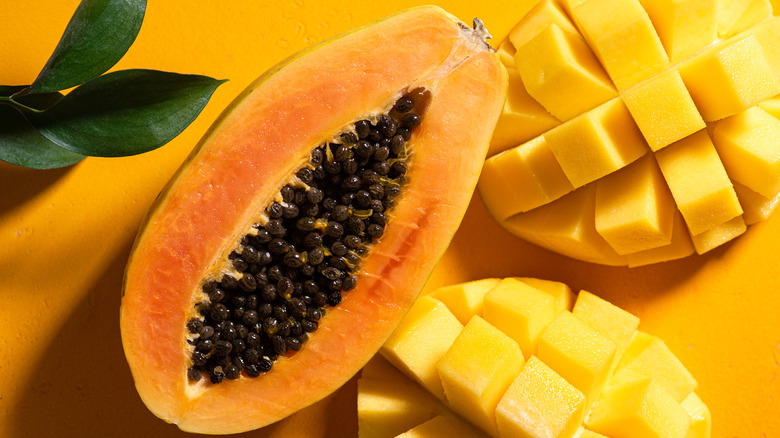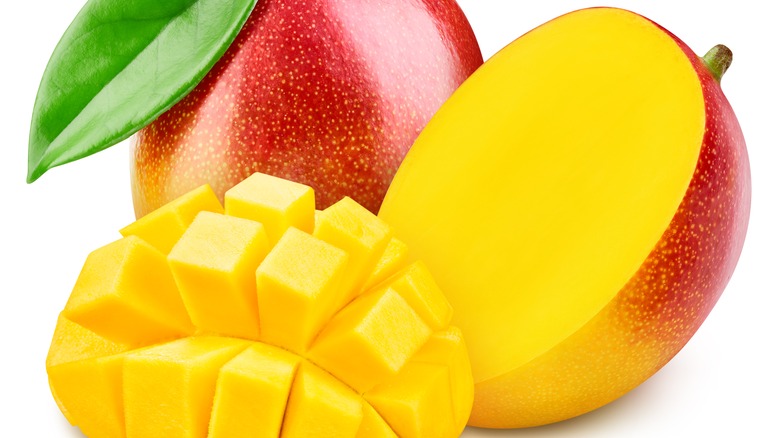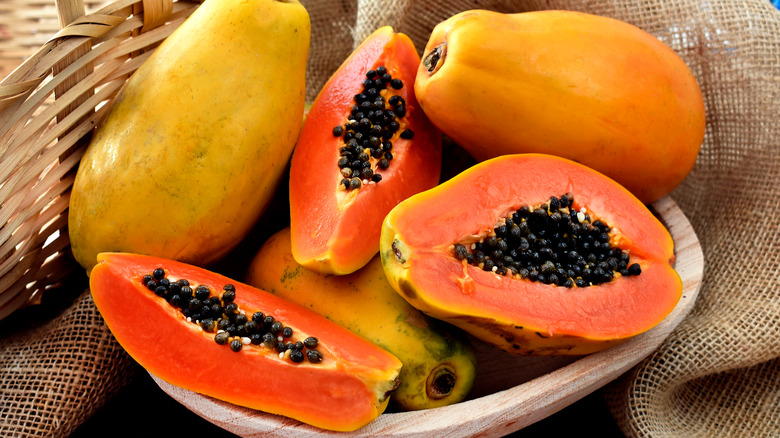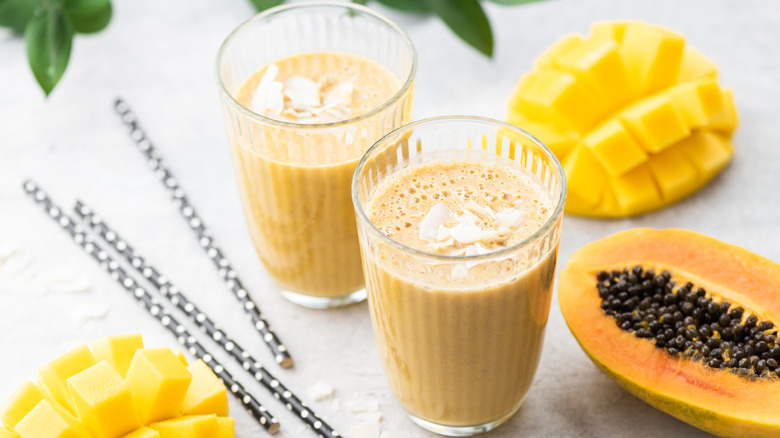Mango Vs. Papaya: What's The Difference?
When you go to make a tropical smoothie, are you adding in mango or papaya? Besides smoothies, both of these tropical fruits are often used in sorbets, ice cream, fruit salads, and other sweet dishes. The two often get mistaken for each other, as they're similar in size, have a yellowish color, and originally come from countries outside the U.S. And while they're both delicious, mangos appear to be far more popular in North America than papayas. According to Fresh Produce, mangos were the 19th highest-selling fruit in the U.S. in 2021, and papayas didn't even make the top 20 list.
That's not to say that papayas aren't popular worldwide. In fact, they're the third-most traded tropical fruit, the University of Florida shares, ranking just under mangos and pineapples. And while papayas aren't one of our most purchased fruits in the U.S., we still accounted for over half of the fruit's global imports from 2007 to 2009. Yet papayas are a little misunderstood, and it's easy to see why people may think they're just a different type of mango. Let's break down the differences between these two tropical fruits, and if you can substitute one for the other.
What is a mango?
Though they're still enjoyed today, mangoes go back as far as 4,000 years, when they were considered a sacred food in India, the Wisconsin Department of Public Instruction shares. Today, we have Asia to thank for three-quarters of the world's mangos, although they also grow in South America, Mexico, Haiti, and Brazil. But they're still perhaps the most beloved in India — the scientific name for mango is mangiferi indica, which translates to "an Indian plant bearing mangos," according to Mango.org.
Since there are over 500 types of mango, they can vary in size and color, although you'll typically see them appear red, orange, yellow, or green. The meat of the fruit is usually orange or yellow, The Spruce Eats shares, and the pit is flat. Mangos are also distinct in their long, oval shape, and they range from being plum-sized to up to five pounds, according to Britannica.
If you've ever eaten a mango at home, you know that there is a specific technique used to cut these fruits. Once you've sectioned out your mango, the trick is to score the meat, push it away from the skin, and scrape off the fruit (or just bite it off the skin). It's a little extra work, but once you get there, you'll be able to enjoy the deliciousness of a ripe mango — sweet, creamy, and soft, with a hint of floral flavor (via Foods Guy).
What is a papaya?
So what makes a papaya different from a mango? For starters, while mangos were originally Asian tropical fruits, papayas actually came from the Western hemisphere. According to the University of Florida, small papayas were first grown in Barbados, and later cultivated in Hawaii, while large papayas come from Cuba. However, Asia entered the picture later, as India is now the world's leading papaya producer, ranking just above Brazil and Indonesia, the Western Institute for Food Safety & Security shares.
Perhaps the most tangible difference to consumers, however, lies in the papaya's appearance and flavor. While mangos are oval-shaped, papayas are pear-shaped, with a longer neck that sticks out. They're typically yellow-green on the outside, and turn more yellow as they become ripe, according to The Spruce Eats. Once you cut them open, the difference between the two fruits is the most obvious. Papayas are bright orange on the inside, Mango.org shares, with an array of small black seeds that look a bit like capers.
If you were to bite into both fruits with your eyes closed, however, you would notice some similarities. Mangos and papayas are sweet and creamy, although papayas are a little less sweet and a bit more refreshing — they're often compared to cantaloupe in flavor (via Kids Are Great Cooks). Unlike a mango's sweet aroma, some find a papaya's smell unappealing, which can be attributed to an enzyme called papain that is similar to our digestive enzymes, Plant Prosperous shares.
Can you use mango and papaya interchangeably?
Despite their differences, mangos and papayas actually work quite well as substitutes for each other in recipes. You'll have to know the differences in preparing them — cutting a mango is a little more complicated than scooping out papaya flesh — but once you've extracted the fruit from the skin, they're often interchangeable.
Mango and papaya work particularly well as swaps in recipes that look to raw fruit for a tropical twist, like fruit salads and sangria, Livestrong explains. Even tropical savory recipes like ceviche and salsa can use papaya instead of mango, according to Foods Guy, and it's important to make sure the papaya is as ripe as the intended mango in the recipe. The swap can work both ways, as Thrive Cuisine also recommends substituting papaya with mangos, although you'll want to pick a green-red mango for closest papaya replacement.
If you're lucky enough to get your hands on both fruits, they also make for a delicious pairing. Mango.org suggests combining mango with ginger, mint, and papaya in a recipe (perhaps a smoothie?) for a spicy, fruity combination. Or whip up some mango papaya ice cream — the fruits' textures will make for a creamy concoction, while the mango's tanginess will balance out the overall sweetness, according to Happy Muncher.



